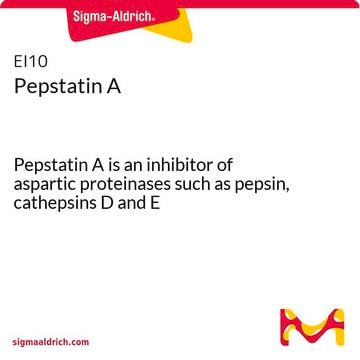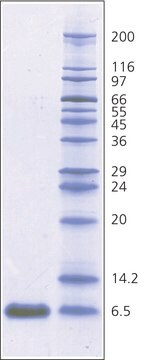11004638001
Roche
Chymostatin
Sinónimos:
Chymostatin, N-(Nα-Carbonyl-Cpd-X-Phe-al)-Phe (Cpd = capreomycidine) (capreomycidine = [S,S]-α-(2-Iminohexahydro-4-pyrimidyl)glycine)
About This Item
Productos recomendados
form
powder
Quality Level
mol wt
Mr = 607.71
packaging
pkg of 10 mg
manufacturer/tradename
Roche
mp
205 °C
solubility
acetic acid: soluble 20 mg/mL
storage temp.
2-8°C
SMILES string
OC(C(NC(NC(C1NC(NCC1)=N)C([F,Cl,Br,I]C)=O)=O)CC2=CC=CC=C2)=O
InChI key
MRXDGVXSWIXTQL-HYHFHBMOSA-N
¿Está buscando productos similares? Visita Guía de comparación de productos
General description
Application
Biochem/physiol Actions
Quality
Formula variant
Preparation Note
1 U chymotrypsin is inhibited to 49% of the original activity by 1.8 μg of chymostatin.
Thin-layer chromatography: butanol/methanol/H2O = 4 / 1 / 2
Working solution: Soluble in glacial acetic acid or DMSO to 20 mg/ml. Sparingly soluble in water, methanol, or ethanol. Insoluble in ethyl acetate, petroleum and ethyl ethers, hexane, or chloroform (CHCl3).
It is recommended to dissolve the inhibitor in 1% acetic acid in higher concentration and to adjust the concentration wanted with phosphate buffer, 0.05 M, pH 7.0, which is common for chymotrypsin assay.
CAUTION: DMSO (Dimethyl sulfoxide) will permeate the skin, carrying solubilized protease inhibitors. Always wear appropriate protection for eyes, skin, etc.
Storage conditions (working solution): -15 to -25 °C
Dilute solutions should be stored frozen in aliquots at -15 to -25 °C and are stable for approximately one month. Avoid repeated freezing. Growth of microorganisms should be avoided as proteases from microbial origin may hydrolyze the peptides.
Other Notes
Storage Class
11 - Combustible Solids
wgk_germany
WGK 1
flash_point_f
Not applicable
flash_point_c
Not applicable
Certificados de análisis (COA)
Busque Certificados de análisis (COA) introduciendo el número de lote del producto. Los números de lote se encuentran en la etiqueta del producto después de las palabras «Lot» o «Batch»
¿Ya tiene este producto?
Encuentre la documentación para los productos que ha comprado recientemente en la Biblioteca de documentos.
Los clientes también vieron
Nuestro equipo de científicos tiene experiencia en todas las áreas de investigación: Ciencias de la vida, Ciencia de los materiales, Síntesis química, Cromatografía, Analítica y muchas otras.
Póngase en contacto con el Servicio técnico














